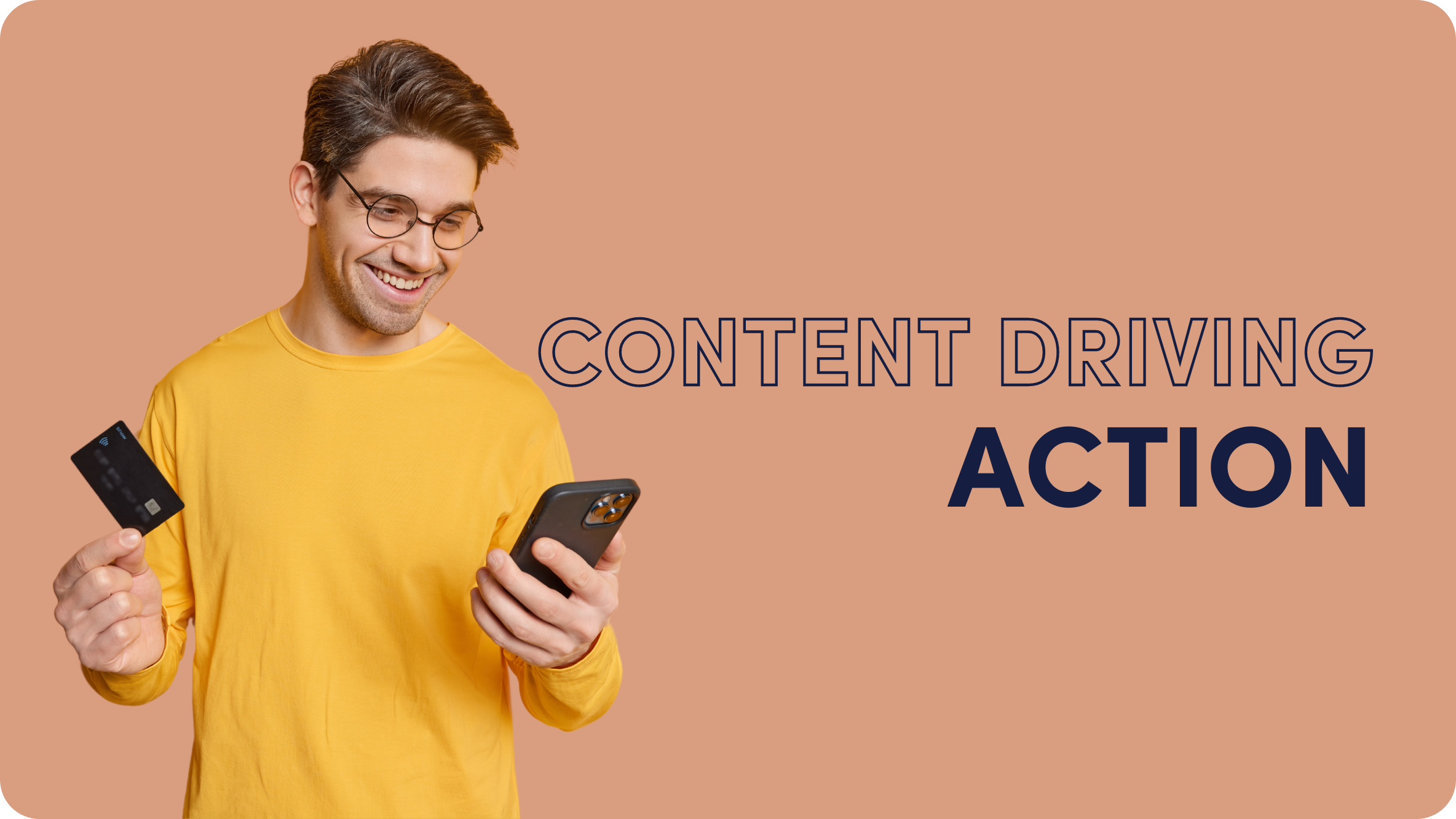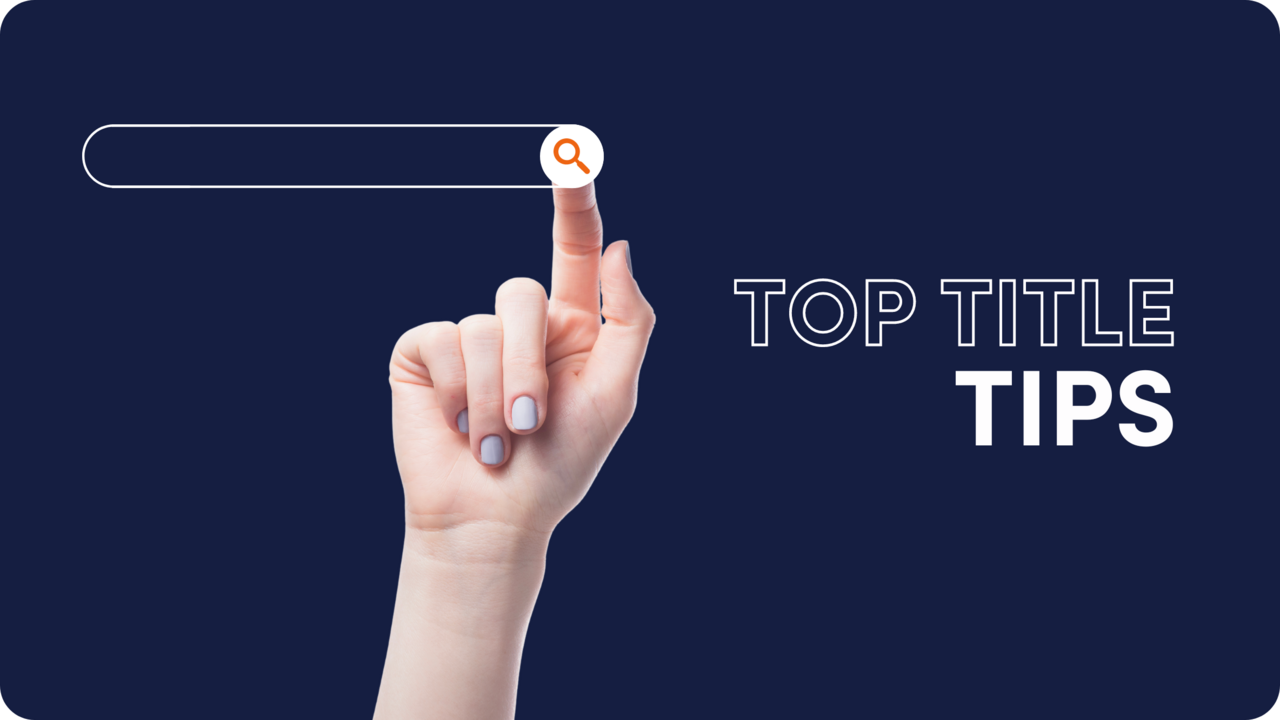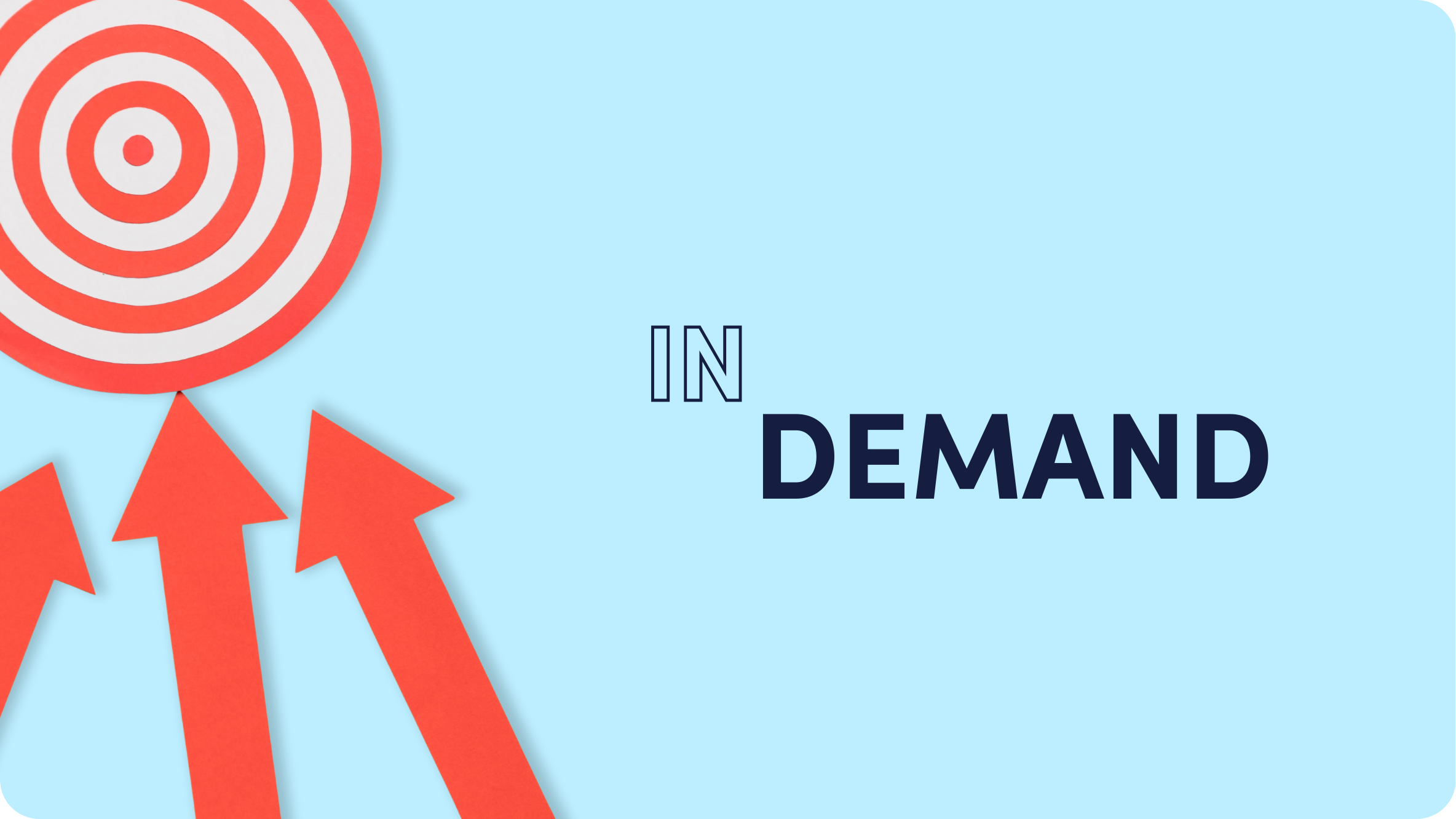How to Write Content that Converts
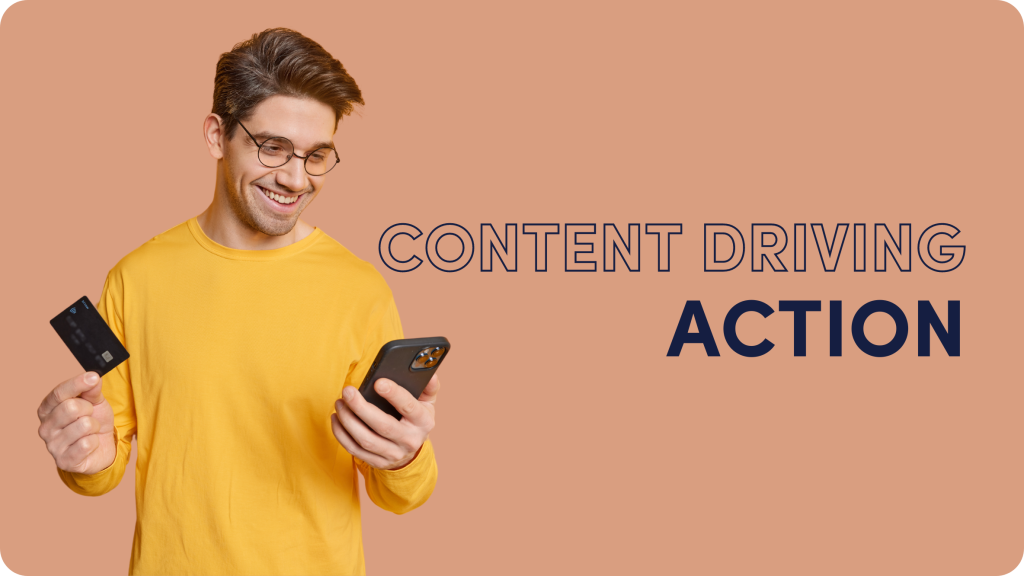
Marketers leverage content for several reasons, from increasing website traffic to growing brand awareness and generating engagement.
But one of the main reasons is, quite simply, to get more conversions. However, that’s easier said than done, especially in a crowded marketplace where it seems (and rightly so) like there’s a sea of content to compete with.
So, how do you write content that converts?
How can you get people to take action, convert, and become customers after reading your content?
And ultimately, how do you generate a positive ROI from your content marketing strategy?
In this blog post, we’ll cover 7 essential steps to help you write content that converts:
Step 1: Know Your Audience
Are you writing content for your audience based on their actual needs and wants? Or based on what you think they want to read?
There’s a big difference between the two, and it’s so easy to forego this important step when creating content.
Great content – that converts – needs to:
- Target a very specific audience.
- Solve a common problem or pain point of your target audience.
- Provide real value to your readers by giving them a solution to their problem (I know, we hear this all the time – and yet, there’s still so much bad content out there that provides no value whatsoever… just content for the sake of content!)
But to know what your audiences’ problems, needs, and wants are, you need to first know them in greater detail:
- What common problems do they encounter?
- What frustrates them?
- What gets them excited and happy?
Once you get inside their heads and have a clearer idea of who they are, you can create content specifically targeted to them.
Take Neil Patel, for example, the digital marketing guru. In this blog post, he opens with a couple of questions that tap into a specific pain point of the audience: difficulty in keyword ranking, which may be a result of low dwell time, when online users click on a search result and visit a web page, but spend little time there before going back to the search results page.
He then proceeds to give readers tips and strategies that will help them boost dwell time and get better SEO results.
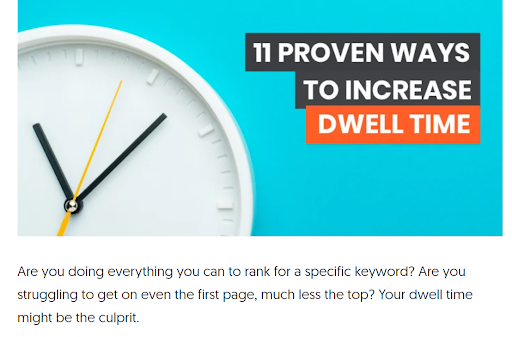
So, your goal as a content marketer is to uncover the issues and pain points of your audience – then, you can use that to create powerful content that helps them in some way. By doing this, you will:
- Increase trust in your brand.
- Give readers a reason to come back to you for more content.
- Give them a reason to subscribe to your newsletter and engage with you on other channels as well.
- And ultimately, give them a reason to convert.
Step 2: It’s All in the Headline
You’ve probably heard this time and time again – but your headlines are incredibly important, so it bears repeating.
It’s as simple as this: if your headline isn’t getting people’s attention and interest, then they’re not going to click and continue reading. And if they’re not going to read your content, then you won’t increase the conversion rate either.
Follow these tips to help you write more effective headlines for content that converts:
- Make sure the headline provides a clear statement of what the content is about so that readers know exactly what they’d get out of reading it.
- Use numbers in your headlines. A Buzzsumo study of 100 million headlines showed that numbers are incredibly powerful and can help you generate more clicks and readers. The most engaging number to include in a headline is the number 10.
- Use emotional headlines where relevant; they too can drive a lot of traffic and engagement. They don’t work in all situations, but hyperbole can be effective in generating emotion that drives action. In the same study by Buzzsumo, it was found that phrases like “tears of joy”, “make you cry”, and “shocked to see” tend to generate more interactions.
- Focus on one pain point that your audience is facing. This helps avoid confusion, which weakens the power of the headline. For example, “How to Increase Dwell Time” is more focused than “How to Increase Dwell Time and How to Boost Your SEO with Increased User Engagement.”
Step 3: Structure Your Content to Increase Readability
Great content is not just about providing information, it’s also about creating an inviting and compelling experience that is easy to digest and leaves the reader wanting more.
With that in mind, here is a checklist to use every time you write content to make it more readable and enjoyable:
- Use the introduction to relate to your reader’s problems and/or clearly explain what the content is about and what they’ll get out of it. Adding a “Key takeaways” or TL;DR section can be a good way to do this.
Here’s an example from the Outbrain blog in a post about “How to Create a Digital Marketing Budget Plan”:
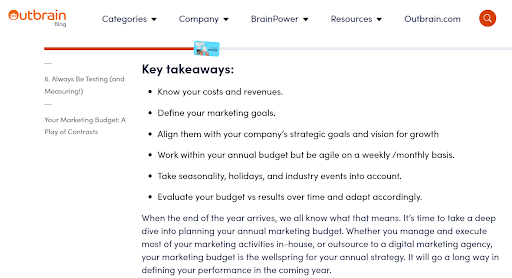
- If you want people to read through your content, then make it easy for them; there’s nothing easy about reading long, chunky paragraphs. Use short sentences and paragraphs, as well as bullet points and lists. Keep in mind that many or even most people are reading your content on small mobile screens. They may be on-the-go, or distracted by other open tabs, social media interactions, and notifications. Great content is clean, well-structured with appropriate white space, and easy on the eye.
- Break down your content with subheadings. It makes it so much easier to read and skim through.
- Use more visuals throughout your content, such as screenshots, photos, videos, GIFs, and more. This provides “breaks” within your content and supports the text with engaging and skimmable visuals.
- Avoid jargon or overly sophisticated phrasing. Always use language that your audience will understand easily and that speaks to their style and level.
Step 4: Write More Personalized Content
Another important step in increasing conversions from content is to write personalized content for different segments of your audience.
Whatever your niche, the audience is not one unified mass of people with the same questions, needs, and wants. There are usually various buyer personas who represent different types of audiences or potential customers.
If your goal is to increase conversions, then you need to write targeted content for all of these audience segments, focusing on their specific and unique needs and pain points.
Step 5: Include Interactive Elements in Your Content
With so many online content creation tools and AI generative tools now available at reasonable cost (or free), interactive content is much easier to produce. And research shows that it can also be a potent tool for your marketing strategy.
In fact, interactive content generates over 52% more engagement than static content.
When people engage actively with your content, that’s great news for your business: it means they’re spending more time on your site and they’re likely to come back for more, which increases the chances of conversions.
Several types of content use gamification or other interactive elements to engage and excite readers. Here are some popular ones you can try:
- Mini-games: Research shows that they are some of the most effective forms of interactive content in the awareness/discovery phase.
- Interactive infographics: Infographics are still very popular forms of content, but you can make them even better and more engaging by including playful, interactive elements.
- Calculators: Calculators are great interactive content tools because they provide added value to support the content goal. For example, in a blog about how to increase conversion rates, I included a conversion rate calculator to give readers an active and exciting experience, and increase engagement:
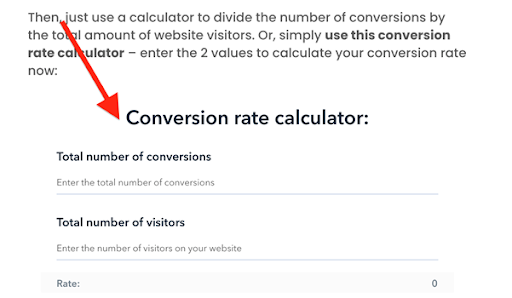
- Quizzes and polls: Everybody wants to feel that their opinion is valued, and polls are a great way to show readers that you care about what they think. Another advantage of polls and quizzes is they drive the audience’s natural curiosity about what others think. Seeing how many people voted the same as you in a poll, or how you performed in a knowledge quiz, is a powerful strategy to increase engagement and conversions with content.
Step 6: Use Content Magnets to Generate Leads
An easy “trick” to boost lead generation is to include lead magnets inside your content.
Lead magnets are high-value content pieces that require the reader to provide their email address or other personal information to access it. Some marketers are not fans of using lead magnets, because the need to provide personal data may turn some readers away. However, when done right, they are a great way to engage the audience and build an email list for future nurturing at the bottom of the marketing funnel.
The best lead magnets are highly targeted, so they have good potential for conversions.
For example, if you were reading a guide on how to rank your website on the first page in search results, then you’d probably be very interested in getting a checklist with all the steps you should take to optimize your content and achieve the top ranking. You may even provide your email address in exchange for a download of that checklist.
Here are some of the best-performing lead magnets you can consider including in your content:
- PDF downloads (particularly for high-value, long-form content, such as how-to guides)
- Checklists
- Templates
- Cheat sheets
- Reports
- Worksheets
- Case studies
- Formulas
- Courses
- Infographics
Step 7: Track and Measure Your Results Consistently
To increase conversions from your content, you need to closely track your content marketing results so that you can understand:
- Which content type generates the most conversions? (ie. listicles, how-to guides, interactive content, and so on)
- Common traits of your best-performing content pieces?
- Which headlines get the most clicks and traffic?
- Which content doesn’t generate enough results to be worth the investment in creating it?
You can find all this out by monitoring your web analytics. Google Analytics is of course a good place to start.
Track your page views, time on the page, bounce rate, and more, and see how they change over time. Set up conversion goals so you can specifically monitor the conversion performance of your blogs or other content assets.
First, you must define your conversion goals and these will vary significantly for different businesses or campaigns. For example, buying a product or booking an appointment are clear conversion goals. Other examples of conversions can be things like submitting a contact form, downloading an ebook, or signing up for a newsletter – these are all mid-funnel conversion leads and if nurtured correctly, they may become the ultimate conversions (paying customers!) down the line.
Filler Content is so 2015
Writing content for the sake of it – AKA filler content – won’t get you the results you want. With the explosion of generative AI writing tools, marketers perhaps got caught up in all the excitement (masses of fast content, yay!), but it seems to have been premature. According to Google, human-created, original, and authentic content is given preference over AI-generated content.
Instead of just churning it out, you need to carefully craft content that offers huge value to a specific audience segment. That’s how you grow your traffic, engagement, and most importantly, conversions.
